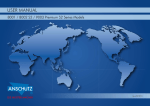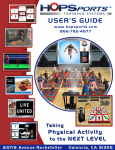Download USER MANUAL - ahg-Anschütz Handels GmbH
Transcript
User Manual
F27A Challenger small bore competition rifle
Issue 06/2010
Contents
1 Components/Terminology...............................4
10Safety catch............................................................ 13
2 Introduction.....................................................5
10.1 Engaging the safety catch............................................. 13
10.2 Releasing the safety catch............................................. 14
3 Key to Symbols...............................................5
11 Removing/inserting the bolt......................... 15
3.1
3.2
General instructions........................................................ 5
Safety instructions........................................................... 5
12 Dismantling/assembling the bolt.................. 15
4 General handling of firearms...........................6
4.1
4.2
4.3
4.4
4.5
4.6
13 Cheek piece.................................................. 20
Important basics.............................................................. 6
Shooting.......................................................................... 7
Maintenance................................................................... 8
Transport......................................................................... 8
Storage........................................................................... 8
Hearing and eye protection............................................ 8
14 Buttplate...................................................... 21
5 Legalities.........................................................8
15 Trigger......................................................... 21
6 Intended use...................................................9
16 Dry firing device........................................... 26
7 Liability...........................................................9
17 Maintenance/cleaning.................................. 27
13.1 Removing the cheek piece.............................................20
13.2 Adjusting the cheek piece.............................................20
14.1 Removing the buttplate.................................................. 21
14.2 Adjusting the buttplate.................................................. 21
17.1
17.2
17.3
17.4
17.5
8 Assembly and attaching the barrelled action.... 10
9 Loading/unloading....................................... 11
9.1
9.2
Loading......................................................................... 11
Unloading..................................................................... 12
2
General.........................................................................27
Cleaning the barrel.......................................................28
Maintenance intervals...................................................29
Trigger maintenance......................................................29
Maintenance of the optical sights..................................29
18 Optical sights................................................ 30
18.1 Mounting.......................................................................30
18.2 Elevation and windage adjustment................................30
18.3 Zero adjustment............................................................30
19 Troubleshooting........................................... 30
20Technical data.............................................. 30
21 Disposal....................................................... 31
22Miscellaneous............................................... 31
23Guarantee.................................................... 31
3
1 Components/Terminology
[1]
[2]
[3]
[4]
[5]
[6]
[12]
[11]
[10]
[9]
[8]
[7]
Fig.1 Overview
[1]
Cheek piece
[7]
Foreend raiser block
[2]
Bolt
[8]
Bolt handle
[3]
Breech case
[9]
Trigger
[4]
Barrelled action
[10]
Rear sight / peep sight
[5]
Front sight (globe f.s.)
[11]
Stock
[6]
Muzzle
[12]
Buttplate
4
2 Introduction
3 Key to Symbols
Dear ANSCHÜTZ Customer,
In this user manual, the following symbols are used to distinguish between
general information and particularly important information:
Thank you for choosing an ahg-ANSCHÜTZ product.
Many spectacular sporting successes have been achieved by marksmen,
olympians and shooters in world and European championships using
ahg‑ANSCHÜTZ products.
ANSCHÜTZ sporting rifles are of high repute as a result of their
well‑engineered design, workmanship and outstanding shooting performance.
Quality and precision are our tradition.
3.1
General instructions
XX is the symbol for an instruction
99 shows the desired result
yy
We wish you much pleasure and sporting success with your new
ahg‑ANSCHÜTZ product.
is the symbol for a list item
3.2
Safety instructions
$$ identifies a safety instruction
Your ahg-ANSCHÜTZ team
Note!
An instruction indicating a specific
course of action.
CAUTION!
Indicates a hazardous situation that can lead to
minor physical injury or material damage
Warning!
Indicates a hazardous situation that can lead to
serious physical injury or death.
5
$$ A firearm must only ever be used for its designated purpose.
4 General handling of firearms
$$ Firearms owners are responsible for ensuring that their firearm is at no time, and especially when
absent, within reach of or accessible to children or other unauthorised persons.
Firearms are dangerous objects requiring the utmost care in their storage and
use. The following safety and warning instructions must be observed without
exception!
$$ Firearms must not be handed over to unauthorised persons.
$$ Modifications to the rifle or the use of non-genuine ANSCHÜTZ accessories$
can lead to malfunctions.
Note!
The firearms legislation of the relevant country
must be respected and complied with.
4.1
$$ Serious or life-threatening injuries and damage can be caused by the use of incorrect ammunition, by
contamination in the barrel or by incorrect cartridge components.
$$ Weapons modified in a way that could affect safety must not be used. If a fault or malfunction is
detected, the weapon must be unloaded and taken to an authorised gunsmith for repair.
Important basics
$$ In the event of external effects (e.g. corrosion, being dropped, etc.), the weapon must be checked by
an authorised gunsmith.
Note!
$$ A weapon must always be treated with the utmost care and be protected from accidental damage.
The use of firearms while under the influence of
drugs, alcohol or medication is not permitted.
Vision, dexterity and judgement can all be
adversely affected.
A good physical and mental constitution is a
prerequisite for using a firearm.
6
4.2
$$ Any firearm must be treated as if it were loaded.
Shooting
$$ Never pick up a firearm by the trigger.
Warning!
$$ Shooting galleries must be adequately ventilated.
Danger to life and causing material damage!
$$ Any bullet trap in the shooting gallery must be completely safe and visible.
Aiming the rifle at people and objects.
hh When the rifle is not in use, keep the muzzle pointing in
a safe direction.
hh The muzzle of a firearm must never be held in a direction
where it can cause damage or endanger life.
$$ No persons may stand in the vicinity of the target during a shoot.
$$ Firearms should not be used when visibility is poor.
$$ Do not shoot into the air, at hard or smooth surfaces, at water or at targets on the horizon.
$$ Do not shoot at targets if the shot could ricochet or be deflected in a dangerous manner.
$$ To prevent accidents or damage to your rifle, never discharge a shot with the muzzle held under
water or up against materials or objects.
$$ Only shoot using the calibre specified on the barrel of the rifle.
$$ Only new, clean, factory-charged ammunition of the calibre permitted for the rifle may be used.
$$ The ammunition must conform to the specifications of the C.I.P. or SAAMI.
$$ Only ever load the rifle immediately before use.
Warning!
$$ Life-threatening injuries and material damage can be caused by the use of incorrect ammunition,
contamination in the barrel or incorrect cartridge components.
Malfunction when shooting!
Shot not discharged after trigger pulled.
hh Do not look down into the muzzle.
hh Keep the muzzle of the firearm pointing in a safe
direction.
hh Unload the firearm.
hh Remove residues from the barrel.
$$ Only genuine ANSCHÜTZ parts may be used.
7
4.3
Maintenance
4.6
Hearing and eye protection
$$ Ensure that the rifle is unloaded before and after use, or during maintenance and cleaning.
4.4
Note!
Transport
For your own safety, approved hearing and eye
protection should be used when shooting!
Shooting without safety equipment can result in
damage to your hearing and sight.
$$ Firearms may only be transported in an unloaded condition and in locked containers.
$$ Only transport firearms in a clean, dry condition.
4.5
Storage
$$ Firearms that are not in use must be kept in a secure place under lock and key.
5 Legalities
$$ Firearms must always be stored in an unloaded and uncocked condition.
$$ Ammunition must be kept in a separate place under lock and key.
Note!
The applicable firearms legislation, regulations
and provisions for the relevant country, and
also the safety rules of the hunting and sporting
organisations must be observed.
8
6 Intended use
7 Liability
The F27A Challenger small bore competition rifle is a single loader competition
rifle. It must only be used on shooting ranges (for sporting disciplines) and may
only be used by persons who hold the appropriate firearms certificate.
ANSCHÜTZ will accept no liability or claims for compensation for damage of
any kind arising from:
yy
yy
yy
yy
yy
yy
yy
yy
Its use is subject to the "General Technical Regulations" for all shooting sports
disciplines of the INTERNATIONAL SHOOTING SPORT FEDERATION (ISSF),
Bavariaring 21, 80336 Munich, Germany.
Note!
failure to comply with the instructions in this user manual,
improper treatment or repair,
use of non-genuine ANSCHÜTZ parts,
incorrect handling or care,
negligence,
removal of the sealing lacquer,
unauthorised tampering or
transport damage.
A firearm must only ever be used for its designated purpose.
Caution!
Modifications to or tampering with the rifle or its
parts are forbidden and may possibly infringe
the guarantee conditions.
Alterations of this kind can have an adverse
effect on the safe use of the product and lead
to accidents that endanger life and limb. In such
cases the guarantee is automatically void.
$$ The rifle must be examined for any changes before use on each occasion.
9
8 Assembly and attaching the barrelled action
[3]
[4]
Note!
The stock and the barrelled action are packed
separately for safety reasons and will have to
be assembled.
XX Wipe off any excess oil from the surface of the barrelled action.
[a]
XX Lay the barrelled action [4] in the milled-out channel in the stock [11]
(see Fig. 2).
XX Use the screwdriver provided to screw the bedding screws in position and
to tighten them in steps alternately and evenly.
[a]
Fig.2 Attaching the barrelled action
Note!
XX In order to achieve the correct adjustment we recommend using a torque
wrench Model No. 4506-SW4, which should be set to 5 Nm (50 cmkp).
An audible click, which can also be felt, indicates that the set value has
been reached.
For correct tightening of the action fixing screws
[a], ANSCHÜTZ recommends the use of the
torque screwdriver Model 4506-SW4, which
must be set to 5 Nm.A palpable and audible
clicking while tightening indicates that the set
value has been reached.
XX Settling of the (stock) wood may occur after the initial assembly. For this
reason we recommend that you release the set screws after a short period
and then retighten them accordingly. Each time before you shoot the rifle,
check the fixing of the barrelled action.
XX Screw in the two bedding screws [a] and tighten them alternately and
evenly in stages.
Note!
Settling of the stock wood can occur after the
initial assembly of the barrelled action [4].
ANSCHÜTZ therefore recommends loosening
the action screws [a] after a time and tightening
them again in accordance with Chapter 8.
Note!
The transverse slot on the underside of the
receiver [3] must be pushed on to the iron
abutment inserted in the stock [11].
The receiver [3] must not rest on the abutment.
$$ The attachment of the barrelled action must be checked each time before shooting to ensure that it is
secure.
10
9 Loading/unloading
XX Insert the cartridge into the chamber.
XX Close the breech [2] (push in the direction of the arrow to the end stop).
9.1
Loading
$$ Only ever load the rifle immediately before use.
[2]
Note!
Before the rifle is used for the first time, the
breech and the inside of the barrel must be
de‑oiled with a lint-free cloth.
XX Open the breech [2] (pull back in the direction of the arrow to the end stop).
Note!
Fig.4 Closing the breech
The firing pin is cocked by opening the breech.
Note!
Closing the action guides the cartridge into the
barrel and cocks the trigger.
[2]
99 The rifle is now loaded and ready for shooting.
XX After discharging the shot, open the bolt and pull back.
XX The rifle is made ready to fire again by inserting another cartridge and
locking the action.
Fig.3 Opening the breech
11
9.2
Warning!
Unloading
XX Open the breech [2] (pull back in the direction of the arrow to the end
stop).
Danger to life!
Unintentional discharge as a result of a loaded, unsecured
rifle.
hh Keep the muzzle of the firearm pointing in a safe
direction.
hh Engage the safety catch after loading the rifle.
[2]
XX Engage the safety catch (see Chapter 10).
Warning!
Danger to life!
Unintentional discharge as a result of inattentiveness
while engaging the safety catch or as a result of possible
malfunctions after securing.
hh Even when the safety catch is engaged, the muzzle of a
firearm must never be pointed in a direction where it can
can cause damage or endanger life.
Fig.5 Opening the breech
Note!
Any cartridge that is still in the chamber will be
ejected.
12
10Engaging/releasing the safety catch
XX Close the breech [2] (push in the direction of the arrow to the end stop).
Note!
The safety catch can only be engaged/released
when the rifle is cocked, i.e when the breech
is open (firing pin cocked) or after the loading
procedure/breech closed (firing pin and
trigger cocked). The general "Engage/Release"
procedure is described as follows.
[2]
10.1 Engaging the safety catch
Fig.7 Closing the breech
XX Open the breech [2].
XX Pull the trigger.
XX Slide the safety catch [x] to the rear (in the direction of the arrow)
("S" is visible).
99 The rifle is unloaded and uncocked.
Note!
$$ For safety reasons, your rifle must be unloaded immediately if it is no
longer to be used. Pull the bolt back to eject the cartridge. In doing so,
observe the safety regulations for handling rifles and pistols. You can then
use a buffer cartridge with signal flag, Item No. 1300, or a signal cord,
Item No. 1400, to indicate that a live cartridge is not in the barrel.
The safety catch must engage exactly and
audibly and must not sit between the end stops.
13
[x]
[2]
Fig.10 Safety catch "Safe"
Fig.8 Closing the breech
99 The rifle is cocked and the safety catch is engaged.
XX Slide the safety catch [x] forwards (in the direction of the arrow)
("F" is visible).
10.2 Releasing the safety catch
[x]
XX Close the breech [2] (push in the direction of the arrow to the end stop).
Note!
The safety catch must engage exactly and
audibly and must not sit between the end stops.
Fig.9 Safety catch "Ready to Fire"
99 The rifle is cocked and the safety catch is released.
14
11 Removing/inserting the bolt
12 Dismantling/assembling the bolt
XX Remove the cheek piece (see Chapter 13).
Note!
XX Pull the breech [2] back (in the direction of the arrow, to the end stop).
Dismantling of the bolt action should only be
carried out by an authorised specialist.
[2]
XX Remove the bolt (see Chapter 11).
(See Fig. 21 for the following designations)
XX Unscrew the connecting nut [5] until the front and rear sections can be
separated.
XX Remove the spring support [6] and the firing pin spring [7].
XX Press the bolt with locking pin [11] out in an upwards direction.
XX Pull the cocking handle [15] to the end stop.
XX Pull the bolt clamping sleeve [19] out of the locking receiver
(a perceptible resistance must be overcome to do this).
Fig.16 Opening the breech
XX Push the releasing lever [z] and simultaneously pull the action [2] out of the
receiver [3].
XX Press out the locking balls [12] to the inside.
XX Press the plunger [17] out of the bolt clamping sleeve [19].
XX Press the driving pin [13] upwards out of the bolt clamping sleeve [19].
[z]
XX Withdraw the firing pin [18] to the rear.
Fig.17 Releasing lever
15
Fig.21 Dismantled bolt
To reassemble, carry out these steps in reverse.
The following must be observed when doing this:
XX Before pushing the locking receiver and the bolt clamping sleeve [19]
together, fit the locking balls [12] into the locking receiver from the inside
(a little grease prevents the locking balls [12] from falling out).
XX When assembling the parts of the bolt, attach the connecting nut [5] to the
locking receiver with the teeth pointing away from the direction of shooting
and screw it together with the bolt body.
$$ When screwing the front and rear parts together, the two parts of the bolt must not be rotated with
respect to one another.
XX The connecting nut [5] has two opposite hand threads, both of which
engage at the same time.
XX Tighten the connecting nut [5] by hand until the bolt body cannot be
turned any more.
XX The point of the firing pin [18] must project from the action face of the bolt
body.
XX Install the bolt (see Chapter 11).
16
13 Cheek piece
14 Buttplate
13.1 Removing the cheek piece
14.1 Removing the buttplate
XX Release clamping screw [D1].
XX Release clamping screw [C1].
XX Remove the cheek piece [1] from the holder.
XX Remove the buttplate [12] from the holder.
XX Fit in reverse order.
XX Fit in reverse order.
14.2 Adjusting the buttplate
13.2 Adjusting the cheek piece
XX To adjust the length, release the clamping screw [C1] by hand
counter‑clockwise until the clamping piece underneath releases the
clamping rings [1] and [2].
XX Coarse adjustment of the cheek piece is effected by actuating the rotary
knob [D1].
XX The adjusting wheel [G1] is used to carry out fine adjustment of the height
of the cheek piece.
XX Set the clamping rings to the desired distance.
XX Axial displacement of the cheek piece is carried out by actuating the screws
[H1] and [J1]. The screws can only be released and tightened using a
screwdriver.
XX Also release the screws [h] and [i] to adjust the angle of the buttplate.
XX The horizontal angle of the cheek piece can be set by actuating the rotary
knobs [E1] and [F1] to give the best adjustment.
XX The clamping screw [C1] should be tightened hand-tight in a clockwise
direction.
[H1]
XX After fine adjustment, the front one of the clamping rings [1] and [2] should
be surrounded by the clamping piece.
XX The screws [h] and [i] should be tightened.
[ J1]
[1]
[h]
[2]
[E1]
[F1]
[G1]
[i]
[D1]
Fig.22 Cheek piece
Fig.23 Buttplate
17
[1]
[C1]
15 Trigger
[8]
Warning!
Danger to life!
Danger to life from loaded firearm.
hh Make sure that the rifle is unloaded when carrying out
alignment and adjustment procedures.
[7]
Caution!
[6]
[4] [5]
Physical damage!
[1] [2]
[3]
Damage to the trigger caused by the breech not being open
when the trigger is changed.
hh Open the breech when changing the trigger.
Fig.24 Trigger
Key (to Fig. 24)
18
1
First stage adjusting screw
2
Second stage adjusting screw
3
Trigger blade
4
Trigger stop adjusting screw
5
First stage pull adjusting screw
6
Trigger weight adjusting screw
7
Trigger cam
8
Firing pin
1 Trigger weight
2 First stage weight (only with two-stage triggers)
Adjusting the trigger weight by means of adjusting screw [6]:
yy turn clockwise = trigger weight is increased (+)
yy turn anticlockwise = trigger weight is reduced (-)
Adjusting the first stage weight by means of adjusting screw [5]:
yy turn clockwise = first stage weight is increased (+)
yy turn anticlockwise = first stage weight is reduced (-)
The trigger and first stage weights are mechanically interdependent. Any
adjustment always results in a small concurrent change in the trigger or first
stage weight.
The trigger and first stage weights are mechanically interdependent.
Any adjustment always results in a small concurrent change in the trigger or first
stage weight.
Moving the trigger cam
yy lowest setting of the cam = least trigger weight
yy highest setting of the cam = highest trigger weight
3 Sear engagement
The sear engagement denotes the travel from the second stage to the release
of the trigger.
Note!
Warning!
A 2 mm Allen key and maybe tweezers will be
needed to adjust the trigger cam.
yy
yy
Danger to life!
Unintentional discharge as a result of too short a sear
engagement and/or too low a trigger weight.
hh Do not set the sear engagement too short.
hh Do not set the trigger weight too low.
hh Do not subject loaded and unsecured rifles to impact
and do not use force to close the breech.
turn anticlockwise = loosen fixing screw
turn clockwise = tighten fixing screw
After the trigger cam has been moved it will be necessary to check the sear
engagement (according to the subsection "Sear engagement") and readjust it if
necessary.
Fine adjustments are made to the trigger and first stage weights by means of
adjusting screws [6] (trigger weight) and [5] (first stage weight).
Caution!
Adjusting the sear engagement on a two-stage trigger by means of adjusting
screw [2]:
yy turn clockwise = sear engagement is shortened
yy turn anticlockwise = sear engagement is lengthened
Physical damage!
Risk of fracturing the clamping screw with too high a torque.
hh Ensure that the trigger cam is correctly seated.
19
Setting the optimum sear engagement:
4 First stage travel (only with two-stage triggers)
$$ The rifle must be unloaded.
XX Cock the rifle and release the trigger (check whether the trigger releases
as desired).
First stage travel denotes the travel of the trigger blade from the zero position to
the second stage.
Setting the first stage travel by means of adjusting screw [1]:
yy turn clockwise = first stage travel is shortened
yy turn anticlockwise = first stage travel is lengthened
If the sear engagement is too long:
There is a short travel from the second stage to the release of the trigger
(so-called "pull" or "tug").
XX After cocking and releasing the trigger, turn adjusting screw [2] clockwise
in steps (approx. 1/8 turn each time).
Warning!
Danger to life!
The first stage travel adjusting screw is set beyond the second
stage function.
hh Never turn the first stage travel adjusting screw beyond
the second stage function.
hh Never remove the first stage travel completely in order to
convert the two-stage trigger to a single stage trigger.
XX Repeat the procedure until the second stage is no longer perceptible.
XX Then turn back 1/5 turn anticlockwise.
99 The optimum sear engagement is now set.
If the sear engagement is too short:
There is no longer any second stage. The trigger releases indefinably without a
second stage.
XX After cocking, turn the adjusting screw [2] at least 1/4 turn anticlockwise,
release the trigger and check whether there is a second stage.
XX If not, repeat the procedure until there is a perceptible second stage.
XX As soon as there is a perceptible second stage, proceed according to the
subsection "If the sear engagement is too long" to achieve the optimum
sear engagement.
To set the sear engagement with a single-stage trigger using adjusting screw
[2], see Point 7.
20
5 Trigger stop
7 Converting a two-stage trigger to a single stage trigger
The trigger stop denotes the travel from the second stage to the end stop for the
trigger blade.
Adjustments:
yy Turn the screw for the first stage travel [1] anticlockwise until the maximum
first stage length has been set.
yy Cock
yy Turn adjusting screw [2] (second stage) anticlockwise until the trigger
releases.
yy From this setting, turn adjusting screw [2] approx. 1/4 turn clockwise.
99 The trigger is now adjusted for single stage; there is no longer any first
stage travel.
Setting the trigger stop by means of the trigger stop adjusting screw [4]:
yy turn clockwise = trigger stop is shortened
yy turn anticlockwise = trigger stop is lengthened
Caution!
Malfunction!
Trigger stop adjusting screw has been turned beyond the
actuation point (trigger does not actuate).
hh Do not turn the trigger stop adjusting screw in beyond
the actuation point.
Warning!
Danger to life from automatic firing!
Automatically firing shots and malfunctions caused
by minimally set trigger weight and too short a sear
engagement.
hh Do not set the trigger weight too low.
hh Do not set the sear engagement too short.
6 Moving the trigger blade
Release clamping screw [3]. The trigger blade can both be moved along the
guide and also pivoted to the side.
21
8 Converting a single stage trigger to a two-stage trigger
yy Turn the trigger stop adjusting screw [4] approx. 2 1/2 turns anticlockwise
(set the max. trigger stop longer).
yy Release the safety catch and cock the rifle.
yy Turn adjusting screw [2] clockwise by approx. 2 1/2 turns.
99 The second stage is now perceptible.
The trigger does not catch the firing pin:
yy Adjusting screw [1] (first stage) is screwed in several turns too far.
yy Check that the tension spring is not damaged and is fitted correctly.
The single stage trigger is set too tight:
yy Turn adjusting screw [2] clockwise in 1/4 turn steps until the firing pin [8] is
caught.
$$ To set the optimum sear engagement, the procedure in Chapter 3 ("Setting the optimum sear
engagement") must be followed.
XX If required, the trigger characteristics can be set to the desired values as
follows: first stage travel per Point 4, trigger stop per Point 5, trigger weight
per Point 1 and first stage weight per Point 2.
The catch link return spring is too weak or is defective:
yy The trigger must be returned to the factory for repair.
9 Trigger malfunctions caused by misadjustment
Proceed as follows in the event of malfunctions caused by a misadjusted trigger:
XX The trigger function must be checked after every change.
XX When the malfunction has been rectified, check the desired trigger
characteristic and adjust it again if necessary.
The trigger catches the firing pin but does not fire when pulled:
yy Check whether the safety catch is engaged.
yy Check that the trigger cam [7] is present and screwed on correctly.
yy The trigger stop adjusting screw [4] is screwed in a few turns too far (turn
screw [4] anticlockwise by a few turns until the firing pin [8] releases once
more when the trigger is pulled).
22
16 Dry firing device
17 Maintenance/cleaning
The length of the firing pin is factory-adjusted to ensure that the cartridge
detonates reliably. Long periods of dry firing without a cartridge or a case in
the chamber can cause damage to the firing pin or the rim of the chamber. For
this reason, either a spent cartridge case (replace approx. every 5 shots) or a
damping disc (1927F-40) should always be used.
17.1 General
Warning!
Danger to life!
With this device, match training can be carried out at any time without the use
of ammunition.
Danger to life from loaded firearm.
hh Ensure that the rifle is unloaded before use or during
maintenance and cleaning work.
Installation
XX Remove the bolt [2] (see Chapter 11).
XX Unscrew the connecting nut [c].
XX Withdraw the bolt body [d] from the rear part of the bolt.
XX Fit the damping disc [b] on the firing pin [a].
Caution!
XX Screw the bolt body [d] and the rear part of the bolt together evenly by
means of the connecting nut [c].
Injury and material damage!
XX Cock the bolt [2] and commence use.
Danger of injury or material damage as a result of not
removing the oil from the barrel and chamber.
hh Each time before shooting, any oil or foreign objects
must be removed from the barrel and chamber.
$$ The damping disc must be removed again before a competition.
[b]
[2]
[a]
[c]
[d]
Note!
The rifle should be protected from dust, sand,
moisture, heat and damaging influences.
Fig.25 Dry firing device
23
Note!
Caution!
Always look out for any changes or damage
that may occur to the rifle.
In the event of a change or damage, the rifle
must immediately be taken to an authorised
gunsmith or sent to ANSCHÜTZ for inspection.
After each use of the rifle, apply a thin film of
oil to the steel parts and thoroughly clean the
barrel.
When the rifle is transported from cold to warm
rooms, condensation can form on the metal
parts and inside the barrel. If this condensation
is not quickly dried off, it can possibly lead to
surface rust.
Note!
The rifle case / soft case should be cleaned
regularly and any dust and fluff removed.
Rifle cases and soft cases should have a smooth,
dust-repellent lining.
When not in use, the rifle case / soft case should
always be left open to allow moisture to escape.
Enclosing a desiccant can reduce the moisture
content.
Note!
To reduce the risk of breaking the stock during
transport, ANSCHÜTZ recommends separating
the barrelled action from the stock, especially
during air travel.
24
17.2 Cleaning the barrel
17.3 Maintenance intervals
Note!
If the barrel is only slightly dirty, use a plastic brush to clean it.
XX Lightly oil the plastic brush and push it through the barrel from the cartridge
chamber end with a suitable cleaning rod.
The stock can be cared for with a special stock
cleaning agent.
Before the competition
yy Carefully remove any oil from the rifle.
$$ The de-oiling of the rifle should be carried out at room temperature, as too many residues can be left
in the barrel if it is very cold.
Fig.26 Plastic brush
If the barrel is very dirty, use a bronze brush together with a suitable barrel
cleaner.
After the competition
yy Pass a dry brush through the barrel (to remove powder residues).
yy Allow the rifle to warm up to room temperature with the breech and the
snow cover opened.
yy Carefully remove condensate from the outside parts.
yy Dismantle the bolt action (see Chapter 12) and likewise remove the
condensate from the individual parts.
yy Oil the firearm with suitable gun oil.
yy Clean the barrel with a plastic brush and gun oil.
Note!
Pay attention to the user instructions for the
cleaner!
If very dirty
yy Clean the barrel with a bronze brush and a suitable barrel cleaner.
yy Wipe the firearm down with an oily cloth.
Fig.27 Bronze brush
XX Pull a woollen swab through the barrel several times to dry it.
Yearly
yy Take the rifle to a dealer/gunsmith for inspection.
Note!
It is essential to re-oil the barrel after using
ammonia-containing cleaning agents, to avoid
the risk of corrosion.
25
17.4 Trigger maintenance
yy
yy
yy
17.5 Care and maintenance of the muzzle tube:
Lubricate the pivot bearing once a year with a thin, low‑temperature oil.
Dab a small quantity of oil between the bearing parts with a needle.
To avoid gumming, adhesion or soiling of the trigger parts, never wash out
the inner parts of the trigger with a spray or oil.
yy
yy
yy
$$ No dirt, solvent residues, grease or unsuitable oils must get into the trigger assembly during
maintenance of the rifle. ANSCHÜTZ recommends cleaning the rifle on its side or with the stock
pointing upwards, which will prevent any adverse effects on the trigger assembly.
yy
yy
yy
After each use, the powder and moisture residues which collect in the
muzzle tube must be removed because they could have a negative effect
on the shooting performance and safety of your rifle.
Release the muzzle tube clamping screws.
Pull the muzzle tube away in the direction of the shot. The removed muzzle
tube should be cleaned thoroughly to remove all residues.
Clean the muzzle carefully using a slightly oiled lint-free cloth.
Slide the muzzle tube into position, making sure that the groove in the tube
engages with the fixing pin on the barrel.
Tighten the clamping screws to approx. 6.0 Nm (60 cmkp).
17.6 Maintenance of the optical sights
Note!
The ANSCHÜTZ rear sight is a precision unit and
consequently requires the utmost care when
handling.
Intensive care and maintenance guarantee
perfect function.
The rear sight must be protected from dust and dirt.
Spindles must not be oiled or greased.
26
18 Optical sights
19 Troubleshooting
Note!
Warning!
Operating and maintenance instructions can
be found in the individual manufacturer's
documentation.
In the event of malfunctions (e.g. shots not
discharged, etc.) the rifle must be unloaded,
secured and taken without delay to a specialist
dealer / gunsmith or sent to ANSCHÜTZ.
18.1 Mounting
The rear sight is slid on to the 11 mm wide V-block rails and locked in a suitable
position using the 2 clamping screws (just tighten hand-tight).
Technical data
18.2 Elevation and windage adjustment
Version F27A-660
The elevation and windage adjusting screws have click stops. The position of
the aiming point is moved from click to click.
yy Elevation when shooting high = turn rotary knob in "H" direction
yy Elevation when shooting low = turn rotary knob in "T" direction
yy Windage when shooting to the right = turn rotary knob in "R" direction
yy Windage when shooting to the left = turn rotary knob in "L" direction
18.3 Zero adjustment
Calibre
.22 l.r.
Barrel length
66 cm
Rifling
66 cm
Overall length
106 –109 cm
Barrelled action length
83 cm
Sighting line
80 cm
Weight
5.3 kg
Version
Single loader
Manufacturer
P. Fortner
Sales and distribution
ahg-Anschütz Handels GmbH
After the sights have been zeroed, the two adjusting screws can be set to the
"0" position.
XX Release the set screws in the rotary knob.
Version F27A-690
XX Position the rotary knobs to "0" on the scale.
Calibre
.22 l.r.
Barrel length
69 cm
Rifling
69 cm
$$ The ANSCHÜTZ rear sight is aligned with zero clearance at the factory and does not require further
adjustment. $
For this reason only the elevation and windage screws may be operated.
Overall length
109 –112 cm
Barrelled action length
86 cm
Sighting line
83 cm
Weight
5.6 kg
$$ Do not turn the knobs beyond the stops at the end of the adjustment travel$
(the pre-tensioned threaded drive can be damaged).
Version
Single loader
Manufacturer
P. Fortner
Sales and distribution
ahg-Anschütz Handels GmbH
XX Tighten the set screws in the rotary knob hand-tight.
27
20Disposal
Guarantee
Disposal of the rifle must be carried out and certified by a specialist dealer or
gunsmith.
< < < < W ARRAN T Y > > > >
This product has been released for sale after the product itself, its
materials and individual components have been subjected to strict
inspection, or the rifle has demonstrated its durability and function
during test shooting. We offer a full guarantee covering material
and manufacturing faults (excluding broken stocks and springs) for
a period of two years, provided that the fault can be shown to have
been present at the time of handover of the product. No warranty
claims will be accepted for faults that are the result of improper
use or unauthorised repairs. The item will be either repaired or
replaced at our discretion. Claims for compensation - put forward
for any legal cause whatsoever – are excluded. This warranty card
- completed and stamped by your dealermust be returnedwith the
item for repairs.
ahg-Anschütz Handels GmbH
Raiffeisenstrasse 26 · 89079 Ulm-Wiblingen / Germany
Tel. +49 - (0)731 - 420 31 · Tel. 420 34 · Fax +49 - (0)731 - 420 33
www.ahg-anschuetz.de · [email protected]
21 Miscellaneous
Additional information is available on the Internet at www.ahg-anschuetz.de.
ANSCHÜTZ provides news concerning this and other products in the
ANSCHÜTZ Newsletter, which you can sign up to for free on the Internet.
SERIAL NO.:
The original group for your rifle at 50 m is affixed to the CD case.
DATE OF PURCHASE:
THIS ITEM WAS BOUGHT FROM:
www.ahg-anschuetz.de
Stamp and signature of dealer
28









































